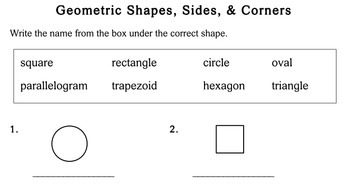
Shapes are the foundation of many early drawing and painting lessons. Additionally, the shapes aid students in learning words like “side,” “corner,” “angle,” “vertex,” “straight,” and “line.”īesides being fundamental to math learning, 2D shapes are critical to life skills and art. Having a good grasp of 2D shapes is also crucial for determining measurements, as students who fail to recognize a rectangle cannot correctly measure it. If students are unable to recognize 2D shapes, they will not be able to recognize 3D shapes as well, and therefore will not be able to handle geometry. Children as young as 2 can recognize simple 2D shapes, such as circles, and can draw them. It is one of the first things children learn about shapes. In this article, we will learn more about 2D shapes.įor future math learning, it is essential to learn 2D shapes. Two or more corners are called vertices (not vertexes!).Ī measure of the turn between the two sides that meets at a vertex is called the angle between the sides. The line segments that make a 2D shape are called its sides.Ī corner at which two sides of a 2D shape meet is called a vertex. The following figure illustrates some of the most common 2D shapes we encounter. A 2-D figure consists of sides, vertices (corners), and internal angles, except for a circle, which is curved. They consist of straight-line segments that are connected in order to form a closed shape. These shapes can vary according to many factors, including the angle, sides, length, width, area, and volume.ĢD Shapes with at least three straight sides are known as polygons. Shapes usually have their own patterns and properties. Cuboids, cones, pyramids, and cylinders are examples of 3D shapes. Dice, for instance, is three-dimensional because it has a length, a width, and a height. Compared to these, a 3D shape (three-dimensional) has three dimensions – length, width, and height. Squares, rectangles, triangles, circles, quadrilaterals, and hexagons are some common 2D shapes. So, it can be said that a 2-D shape does not have any thickness and can be measured in only two faces. The object here consists of a length and width but has neither depth nor height. An example is a piece of paper, which has a two-dimensional shape. In geometry, the term 2D (two-dimensional) refers to a flat plane figure or shape with only two dimensions – length and width, without depth or thickness. Thus, circles are two-dimensional shapes that can fit into a flat plane like other 2D shapes. Their different dimensions, for example, can be used to classify them. It is possible to classify shapes by describing a bigger category of shapes that the shape belongs to. There is also another fascinating area of mathematics to be explored and enjoyed, and that is the area of shape! A shape can be described as a geometric figure. Numbers are typically the first thing that comes to mind when we think of early mathematical education. These children benefit from a knowledge of shapes when studying advanced mathematics. By practicing with shapes frequently, preschoolers will increase their ability to comprehend two-dimensional structures. Young kids usually take longer learning about specific properties of shapes, like how many sides each shape has or how it looks. Relative Sizes of Units – 4th Grade Math – 4.MD.A.Children notice shapes from a young age, even if they don’t know what the shapes are called. ✏️ Interactive – Cut and paste activities and digital movable pieces.įor copyright information and a summary of how this resource can and cannot be used, please review the Terms of Use Page. ✏️ Scaffolded – Worksheets are developed to build on skills with visuals. ✏️ Classroom & Distance Learning Formats – Printable PDFs and Google Slide formats included! Recognize right triangles as a category, and identify right triangles. This unit includes anchor charts, practice, pages, manipulatives, test review, and an assessment to learn and practice classifying two-dimensional figures based on the presence or absence of parallel or perpendicular lines, or the presence or absence of angles of a specified size.


⭐ This printable & digital Google Slides 4th grade math unit focuses on teaching students about two-dimensional shapes.


 0 kommentar(er)
0 kommentar(er)
